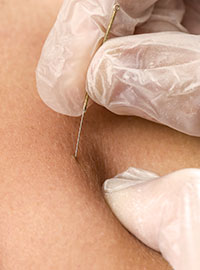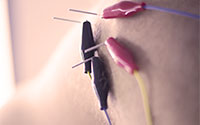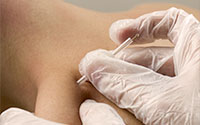Dry Needling

Dry needling is primarily used to relieve muscle pain and cramping but may also improve flexibility. A physical therapist that is certified to use dry needling will insert short, thin, stainless steel filiform needles into pressure points, also called trigger points. These areas are tight or have knots in the muscle. These needles do not contain any type of medication and nothing is injected into the muscle. They are only used to stimulate the muscle. Needles typically stay in the muscle anywhere from 10-30 minutes. Dry needling is almost always used in conjunction with some type of exercise, manual therapy, and education.
What Can Dry Needling treat?
- Back Pain
- Shoulder Pain
- Knee Pain
- Hip and Gluteal Pain
- Sciatica
- Plantar Fasciitis
- Tendinitis
- Migraines and Tension Type Headaches
- Carpal Tunnel Syndrome
- Tennis Elbow
- Trigger Finger
- Bursitis
- Tenosynovitis
- Pelvic Pain
- Night Cramps
- Phantom Pain
- Pain Left Behind from Shingles
- Jaw and Mouth Problems
- Whiplash
What Are The Possible Side Effects Of Dry Needling?
- Soreness during and/or after the treatment
- Bruising
- Bleeding at the location on the needle
- Fatigue
- Fainting
How Can Dry Needling Help?
- Releases trigger points to help relieve pain and/or improve ROM
- Improves pain control
- Reduces muscle tension
- Normalizes dysfunctions of motor end plates which are sites where never impulses are transmitted to muscles






